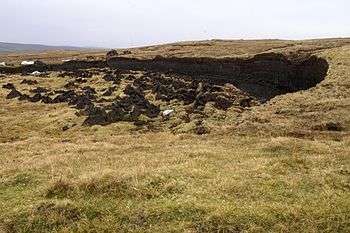Blanket bog

Blanket bog or blanket mire, also known as featherbed bog, is an area of peatland, forming where there is a climate of high rainfall and a low level of evapotranspiration, allowing peat to develop not only in wet hollows but over large expanses of undulating ground.[1][2] The blanketing of the ground with a variable depth of peat gives the habitat type its name. Blanket bogs are found extensively throughout the northern hemisphere - well-studied examples are found in Ireland and Britain, but vast areas of the Russian and North American tundra also qualify as blanket bogs.
In the southern hemisphere they are less well-developed due to the relatively low latitudes of the main land areas, though similar environments are reported in Patagonia,[3] the Falkland Islands and New Zealand. The blanket bogs known as 'featherbeds' on subantarctic Macquarie Island occur on raised marine terraces; they may be up to 5 m deep, tremble or quake when walked on and can be hazardous to cross.[4] It is doubtful whether the extremely impoverished flora of Antarctica is sufficiently well developed to be considered as blanket bogs.
In some areas of Europe, the spread of blanket bogs is traced to deforestation by prehistoric cultures.[5]
Peat harvesting
In many areas peat is cultivated as a fossil fuel and used either in electricity generation or domestic solid fuel for heating. In the Republic of Ireland a state owned agency, Bord na Móna, owns large areas of bog land and harvests peat for electricity generation but that peat is mainly from the raised bogs in the central plains. Bord na Móna used to burn peat in the peat fired generating station at Bellacorick but that closed down many years ago and the area now houses a large windfarm.
Some blanket bogs are now preserved by government organisations in both Ireland and Britain, as this habitat is now under threat from extensive harvesting. Examples of protected blanket bogs include Sliabh Beagh, Bellacorick and Airds Moss.
See also
References
- ↑ Gorham, E. (1957). The development of peatlands. Quarterly Review of Biology, 32, 145–66.
- ↑ Keddy, P.A. (2010). Wetland Ecology: Principles and Conservation (2nd edition). Cambridge University Press, Cambridge, UK.
- ↑ Arroyo, M.T.K., P. Mihoc, P. Pliscoff and M. Arroyo-Kalin. (2005). The Magellanic moorland. P. 424-445 in L.H. Fraser and P.A. Keddy (eds.). The World’s Largest Wetlands: Ecology and Conservation. Cambridge University Press, Cambridge, UK.
- ↑ Hince, Bernadette (2000). The Antarctic Dictionary: A Complete Guide to Antarctic English. Melbourne: CSIRO Publishing. p. 126. ISBN 0643102329.
- ↑ Moore, P. D. (1973). The influence of prehistoric cultures upon the initiation and spread of blanket bog in upland Wales. Nature, 241, 350–353.